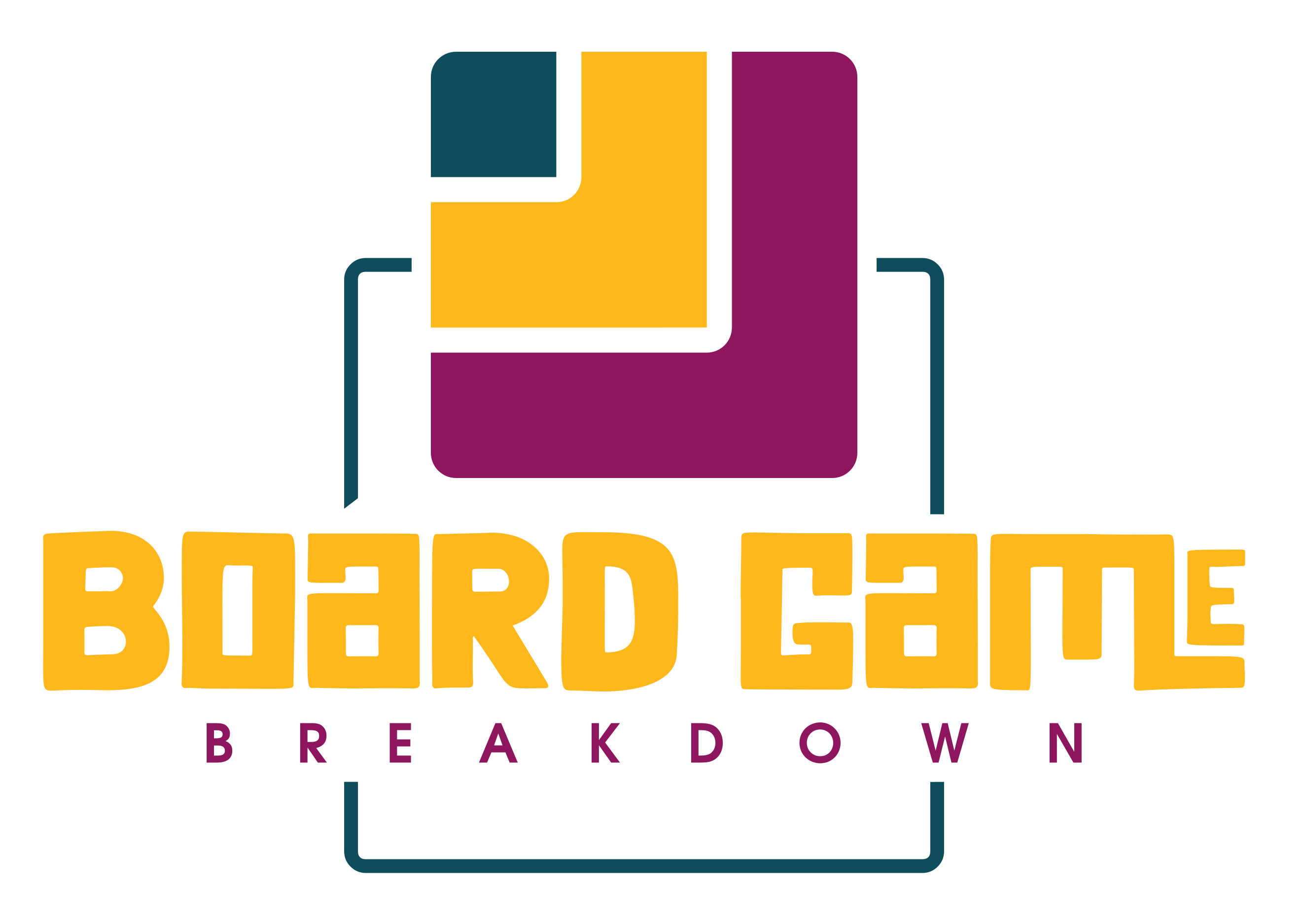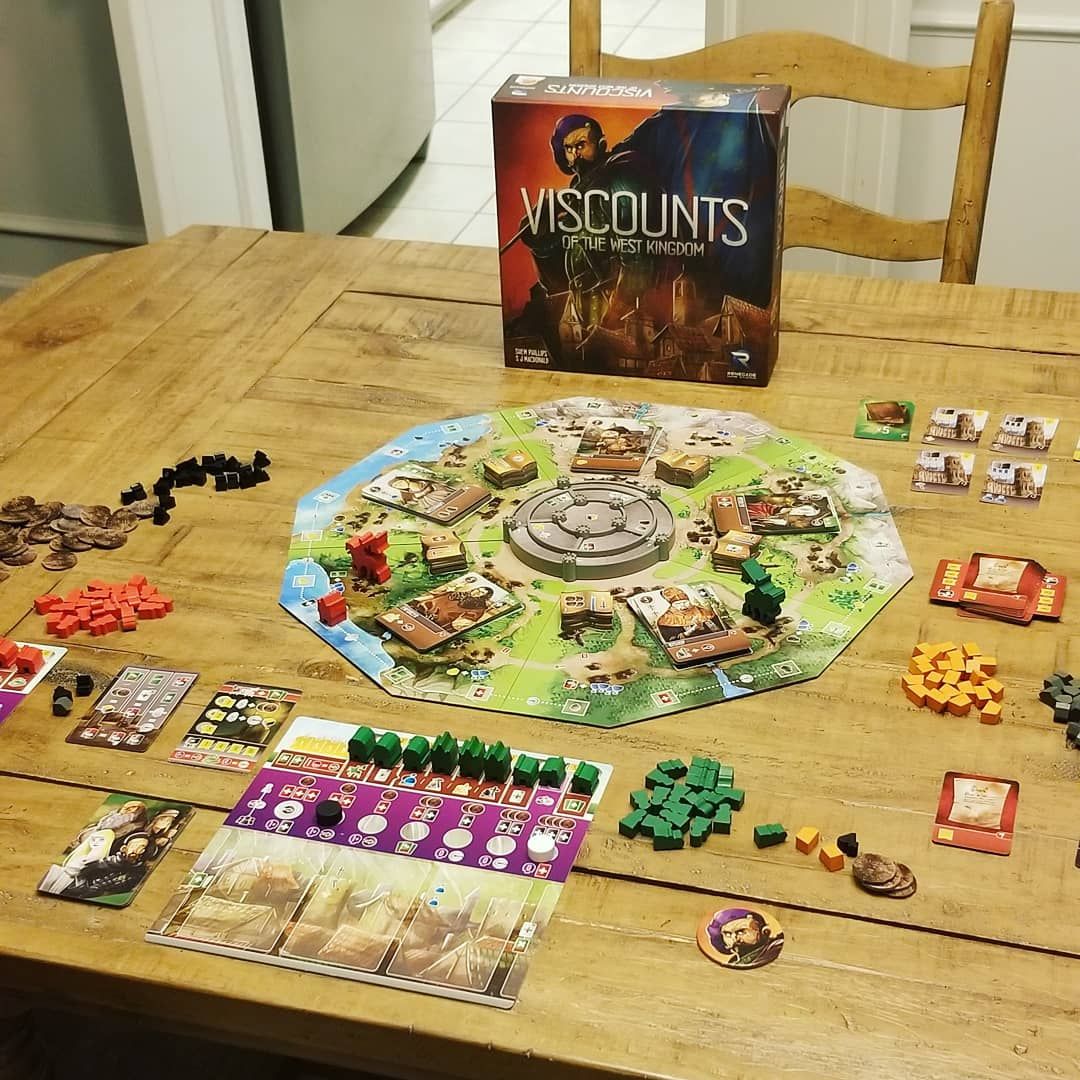
Name: Viscounts of the West Kingdom
Year of Release: 2020
Player Count: 1 – 6 Players
Playing Time: 30 – 60 minutes
Designer: Shem Phillips, S J Macdonald
Publisher: Garphill Games
Primary Mechanisms: Deck Building, Rondel, Hand Management, Variable Player Powers
Weight (According to boardgamegeek.com): 3.45
Overview
This game is my first foray into the “West Kingdom,” as I’ve never played either Architects or Paladins, nor have I played anything in the “North Sea” collection. But it is hard to browse around the web and not see these games mentioned… a lot. So, with that in mind (and a newly won $50 gift card from a drawing at work) I tasked myself with picking out a game from the cadre of Garphill Games. Ended up with Viscounts mostly because I did not want another worker placement game and this one looked like it had enough mechanics that differed from what I already have in my collection. Plus, the praise was flung far and wide, so I made my choice and chose Viscounts.
Was it a good choice for me? Simply put, hell yes! I have already played this solo more times than any other game in my collection, it’s that good. The worst thing about the game is the fact that I cannot stop pronouncing it as “vis-counts” instead of its correct enunciation of “vy-counts.” If that is the only problem, you know it has to be good!
Setup and Components
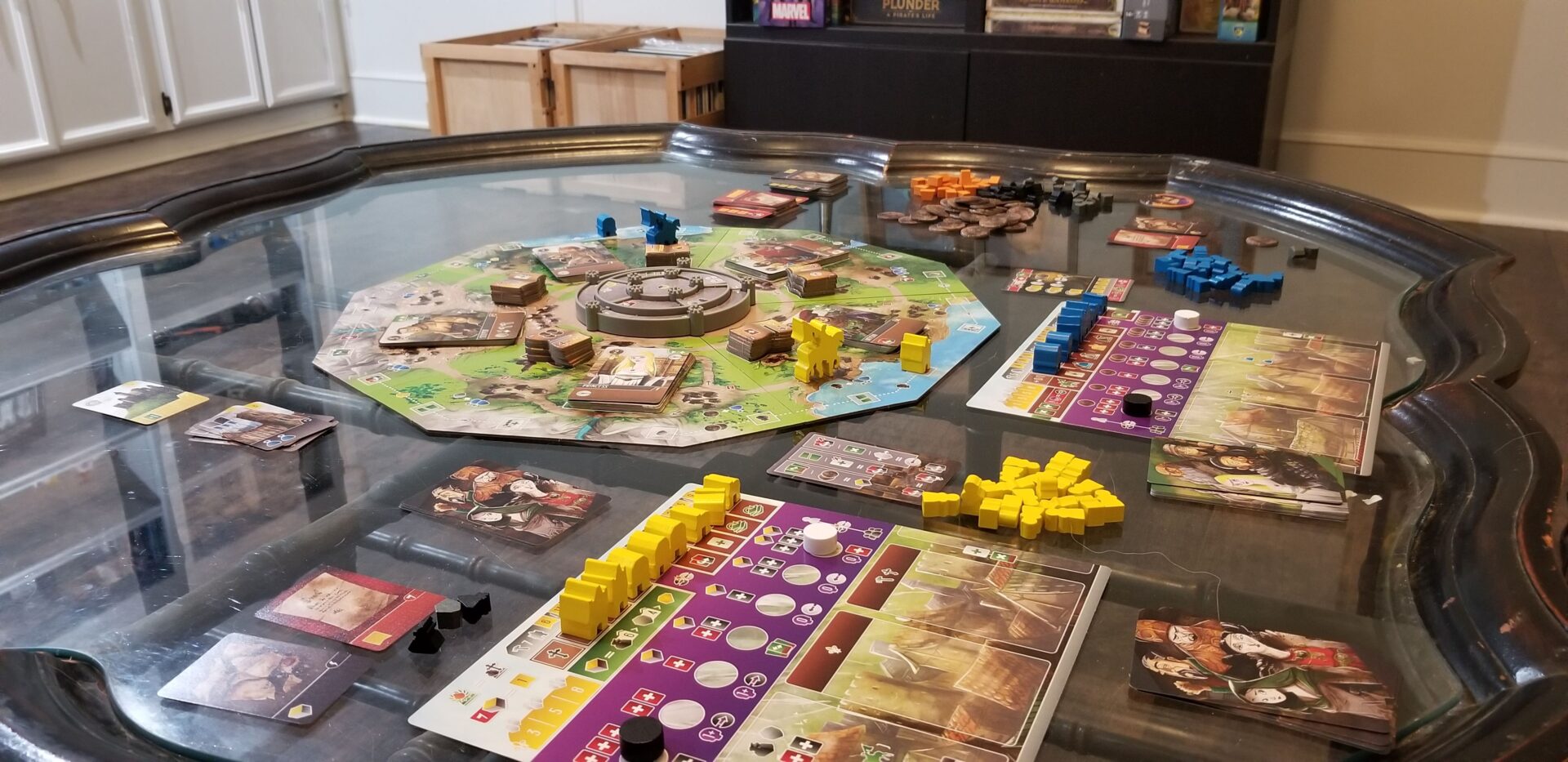
I am not going to lie, there is a lot to setup to get this game going. I’m also not going to lie; I love every bit of it. Some games are just fun to shuffle all the different cards and make their nice equal stacks; line up the rows and rows of little workers or buildings; ensure all the resources are in their appropriate piles (or bowls/dishes if you enjoy that) and spread out just right around the board. This can all be especially true when the components are of a high quality and the instructions are thoughtful and clear; both attributes that Viscounts has. So how does setup work, specifically in the solo mode?
First up, randomize the board and castle. The board is made up of five double-sided pieces that are put together in a circular fashion, with the appropriate side facing up depending on the number of players. Once put together, there is a circular opening created in the center and this is where the castle is placed. The castle is a nice, chunky piece of plastic that locks into the center, keeping all the boards together. However, do not think the castle is just there as a fancy paperweight, it plays a role in one of the main actions of the game (which I will get to later.) At this point, just know that there are cardboard pieces (printed with different icons) that you will have put into each of the tiers within the castle, and the castle can face any way when it is slotted into its circular home, adding a bit more randomness to the setup.
Next, grab a player mat for yourself and one for the virtual player. For yourself, it does not really matter which mat you get, as they are all the same but not so for the virtual player. Each player mat is double sided, with one side being what you (or your friends if you have those) will use and the other is printed with the virtual player’s actions. Each mat allows the virtual player to specialize in one of the core actions of the game: construction of buildings, sending workers to labor in the castle, publishing manuscripts, or utilizing cards/adding cards to their deck. This is a novel approach that I have not seen done in other games where the virtual player is dead set on a certain path to reach victory. At first, I assumed this would hinder the fun of the game, making it too easy to stop the virtual player but trust me, my assumption could not have been further from the truth. Note: for this playthrough session, I chose to play against the virtual player who specializes in manuscripts so from here on out, he shall be known as Manuscript Manny.
Once you have your mats out, time to start putting out all the wooden tokens. These include your player pieces (9 buildings of 3 different varieties, 20 workers, and 1 viscount or “dude on a horse.”) If you have ever played Tapestry, you’ll recognize how to place your buildings on your player mat. They are used to cover the top row of spaces and as you build these structures and move them out onto the main board, they will unveil bonus actions or resources you will then be able to take advantage of. For right now, the workers will hang out next to your mat and your viscount will hang back until a little further in the setup, when he is placed on the main board. You will also want to put out the three resources (gold, ink wells, and stone) as well as the money (silver.) Lastly, you will need to take one black circular token (corruption) and one white circular token (virtue) and place them on your mat at opposite sides. These will play a crucial role in the see-saw elements found throughout the game.
Before we get to the piles and piles of cards, next step is to put out the manuscripts. These are represented by small cardboard pieces that look like an open book. There are 35 manuscripts in total, 5 with grey backs and the rest with black. You will find the grey backed ones and place them face down on the table, then randomly add 6 (black backed) manuscripts on top of this grey one. Do these facedown as well. Once the piles have been generated, you flip them face up (so now the grey backed manuscript is on the top of the pile) and place one pile on one of the manuscript icons around the board. These will be used for when you want to take the “publish manuscript” action throughout the game but more on that later.
Finally, you must get all the cards in order and into their appropriate spots. There are a lot of different variety of cards, but they are all clearly marked and once you setup once or twice, this becomes a breeze. You will grab the 8 player-colored townsfolk cards and put them in front of you. Each of these decks contains the same 8 townsfolk so all players will start with the same configured deck. One thing to note about the solo game, no matter what color the virtual player is, they will not be using the townsfolk cards. Instead, they will be using “scheme” cards, but we’ll get to that in a second. Outside of the player-colored townsfolk cards, there are 68 neutral townsfolk cards. These are shuffled and then split into 5 stacks of comparable sizes and put into their appropriate slots on the board. These cards will be used to help you take actions or can even be bought to add to your deck.
The townsfolk are not the only people here to help you on your quest to… ummmm…. I do not really know what a viscount is supposed to do. Nonetheless, there are also 10 hero cards to help you do all the viscount-y things that viscounts do! You shuffle the 10 hero cards and place two out faceup (with the rest being banished back to the box as they will not get to help during the current game.) There are also 10 player cards that are double-sided and have two responsibilities. Their first reason for being is for two of them to be paired up with the two hero cards mentioned above. You then can choose which hero/player card combination to pick. On this side of the player card, it will detail the starting space for your “dude on a horse” as well as your starting resources, money, and other perks. I would liken this to the Mamas and Papas cards in Viticulture that you are given at the onset of the game. The flip side of the player card acts as a nice player aide to help you remember some of the nuances of the game as you play. For this playthrough, I selected the hero Judith which I had not selected before. She was paired with the player card allowing me to put my viscount token on space 8 of the board as well as building a trading post for free. This was a great pick because by building this first trading post, it allowed me to move my viscount up to one extra space for free, which I have found comes in handy many of the times.
We are on to the final stretch of setup! I mentioned earlier that the virtual player uses scheme cards. These are like other cards found in games, especially those that the Automa Factory has a hand in (Viticulture, Wingspan, Tapestry, etc.) They will basically direct the AI player on what actions to take on each turn. The difference here is that there is a starting scheme deck and then a future scheme deck. The AI player will start with the…. You guessed it, the starting scheme deck but will take certain actions to start shuffling in future scheme cards into the deck. These future scheme cards are typically more powerful and allow for some added difficulty as you are playing. The virtual player mat will instruct you if there are any of these cards you need to remove before starting as they are not always all used. The mat will also tell you what resources to give the AI player. Lastly, whatever player card you did not select, you will place the virtual player’s viscount on that numbered space. The coupled hero card can also go back into the box as the virtual player does not need no stinkin’ hero to kick your butt.
Geeze, Kris, you have already written almost 1,500 words on just the setup alone, aren’t you done? Not yet! There are two more types of cards that play an especially important role in the game. These are the deed and debt cards. They will act as a large contributor to your overall score at the end of the game, but they also act as the game timer, where the game ends once one of these decks is emptied. Depending on the player count, a certain amount of these cards is stacked up to the side of the board and will help countdown to the end of the game. There are a few extra cards that will give bonus points depending on meeting certain goals, but I think I’ve ranted on enough about the setup so let’s get to the gameplay.
Gameplay
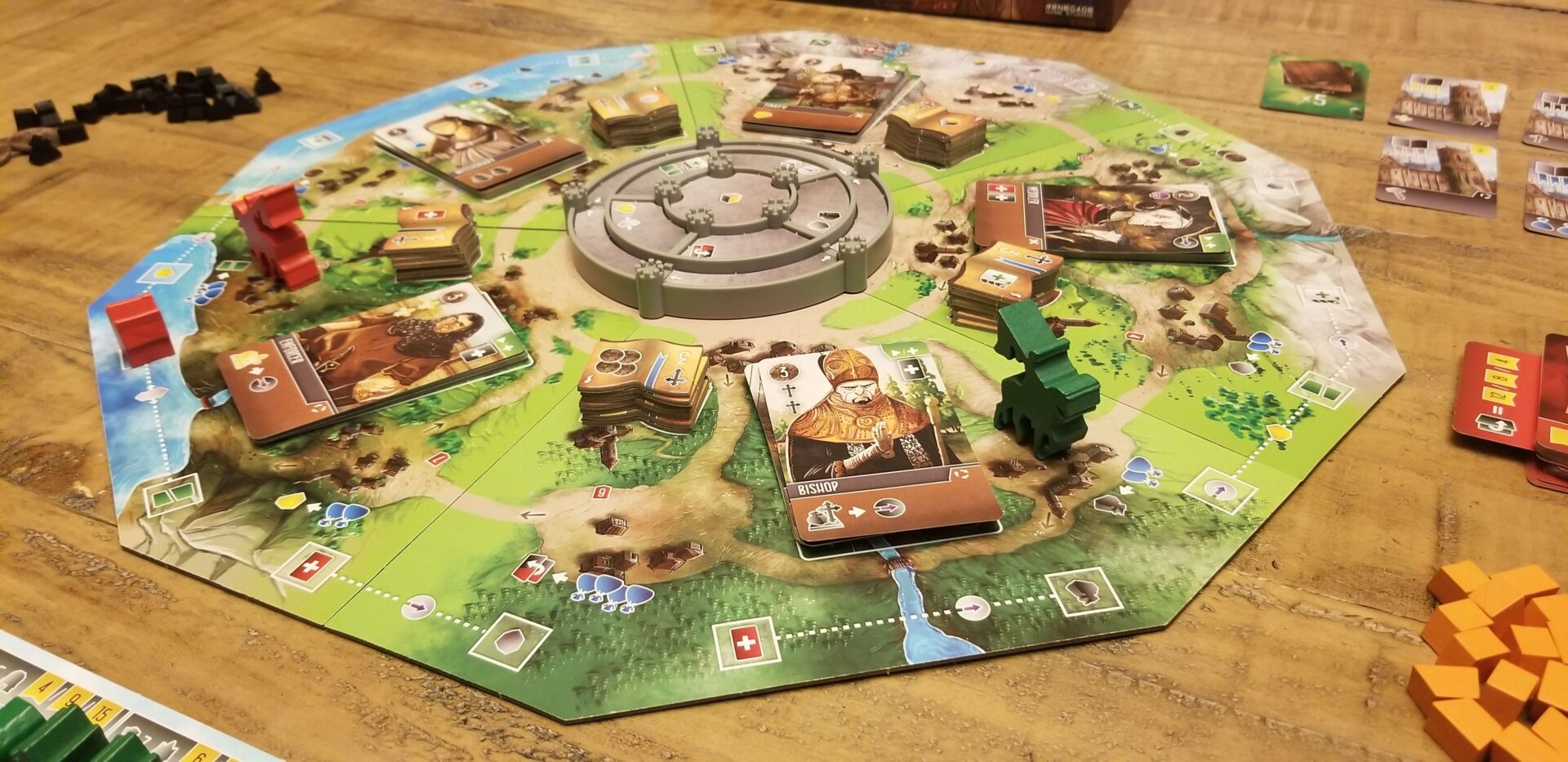
After wading through that slog of a set up description I just wrote, you are probably thinking “this game seems like a convoluted mess!” Honestly, I thought the same thing after reading through the instruction manual for the first time, not because the instructions are bad but just because there is a lot going on. But I promise you, once you start playing, it all comes together flawlessly.
Let us discuss your deck first, as this is going to be the main driver behind what you can accomplish during gameplay. As mentioned, you will start out with the same collection of villagers each game plus one hero card. You will start the game with your hand consisting of 3 cards but can later upgrade to 4 or even 5 cards in your hand at once. On the bottom of your player mat, there are spaces for three cards. Each round, you’ll move any cards you already have on your mat one place to the right and add a new card from your hand on the left most space. The cards you play onto your mat have three different types of actions. First, there are those that are activated as soon as you place the card on the mat. Second, there are actions that are constant for the duration of the card being on your mat. Lastly, some cards’ actions are only activated when the card drops off your mat.
Ok, so you understand when the actions on the cards can be activated, but what are the actions? There are many but typically will fall into categories such as a.) added resources b.) discard or remove cards from your hand c.) gain silver for performing certain actions or d.) hire a neutral villager or do something similar for no cost. I’m sure there are others, but you get the idea. Besides the actions, each card has a silver cost as well as a set of icons that correlate to one of the main actions, you’ll take on the board. When you add a card to your mat, whatever that silver cost number is equates to how many spots you can move your viscount token clockwise around the board. I will get into this in more detail in the next section when I tackle the board.
Building your deck out to include the exact resources and actions you will need is particularly important. I have noticed that it is key to make every turn as efficient as possible. If you do not maximize every turn, the virtual player is going to wipe the floor with you because he never lets up. During this play session, I was very deliberate on cutting out as many cards as I could that did not line up exactly with what I was trying to accomplish. This played out much better than I thought because it kept my deck to a tiny size, allowing me to re-shuffle almost every other turn. This was a plus because every time I shuffled and did not have a skull icon (basically a wild) on my mat, I got to move my virtue token once to the left. This helped me rack up deeds for a lot of end-game scoring.
Besides your deck and what is playing out on your mat, you also have what is going on with the board. The board is basically made up of two rondels, an outer track, and an inner track. The actions you can take depends on which track your viscount is currently on. On the outside track, you can construct buildings, or you can use the trade action, basically a way of spending money to get more resources, deeds, etc. The inner track allows you to publish manuscripts or send workers into the castle. Each of these actions takes resources, stones for construction, ink wells for manuscripts, gold for workers, and silver coins for trading. Let us look at how the actions work:
- Trading is the simplest of the actions. The outer track has different spaces allowing you to get one type of resource, obtain or flip a deed/debt card, by counting how many money bag icons you have showing on your mat. You can then increase this by adding in silver coins to up the number of resources you get back.
- Construction of a building means you turn in either 3, 5, or 7 stone and then build one of your three variety of buildings by placing that building token from your mat onto one of the square spaces on the outside edge of the board. Each square space has an icon that is triggered when you place the building. On top of that, there are icons in between building spots and once both buildings are built, that icon is also triggered.
- During set up, I mentioned you would create 5 piles of manuscripts that are placed out on the board. When you want to publish a manuscript, you must be on the inner track and have enough ink wells to buy the manuscript that sits on the piece of the board you’re on. Sometimes these can cost 3 ink wells, sometimes they can cost up to 7. Once you publish the manuscript, you either get the resource or item that is printed on it, or it gives you an additional way to score points at the end of the game, such as a victory point for every two bag icons you have in your deck.
- Lastly, the inner track allows you to spend gold to put workers in the castle. Depending on the gold amount spent, you can place multiple workers in the outside tier of the castle that lines up with the portion of the board you are on. If you have three workers here, you then move one to the 2nd tier and the other two sideways (one to the left tier and one to the right tier.) You continue to check for this condition and move workers. As they move forward in tiers, more actions are triggered. This can cause a fun cascading affect where you can even bump opposing workers out of the castle. On top of this, these workers will score you points at the finale depending on what tier they stand in.
One awesome part of the game is that there is a mechanism to help pay for actions if you don’t have enough of the given resource. You can pay the silver amount printed on the neutral worker card that is on your portion of the board to “dismiss” this worker. This allows you to remove it from the game but also allows you to use whatever icons are on this card for this one turn in order to boost the resources you hold; in case you need them for a specific action. There is also a one-time perk to be had when you dismiss a card.
Once you have moved your viscount, and taken one of the actions, there are a few things to do to finish up your turn. You must check your virtue and corruption markers (the white and black ones on your mat) for a collision. If they have collided, you resolve the actions and then move them back to their appropriate spot. This collision typically rewards you with a lot of deed or a lot of debt cards but can also reward your opponent depending on the icons they have on their player mat. You can also hire the neutral worker on your spot and place them in your discard pile. Lastly, you draw your hand back up to the appropriate hand size and move on to the next players turn.
In the case of the virtual player, his deck of cards is printed with actions that you resolve moving from top to bottom. Some of the actions will have multiple icons that you attempt to resolve from left to right. Most of the time the actions will revolve around that specific action that the virtual player specializes in, but the scheme cards do branch out some, allowing the virtual player to gain points through the other avenues.
There are other things going on too that for the sake of brevity, I am not going to get into detail with. These includes extra points or resources for being the first to collect a certain set of manuscripts or extra victory points and a larger hand for having the most workers in tier 3 of the castle. Again, I am hoping I’m not making this sound like a jumbled mess because if so, I’m not doing this game any justice. All of its little mechanics really do come together to create a wonderfully memorable experience.
Conclusion
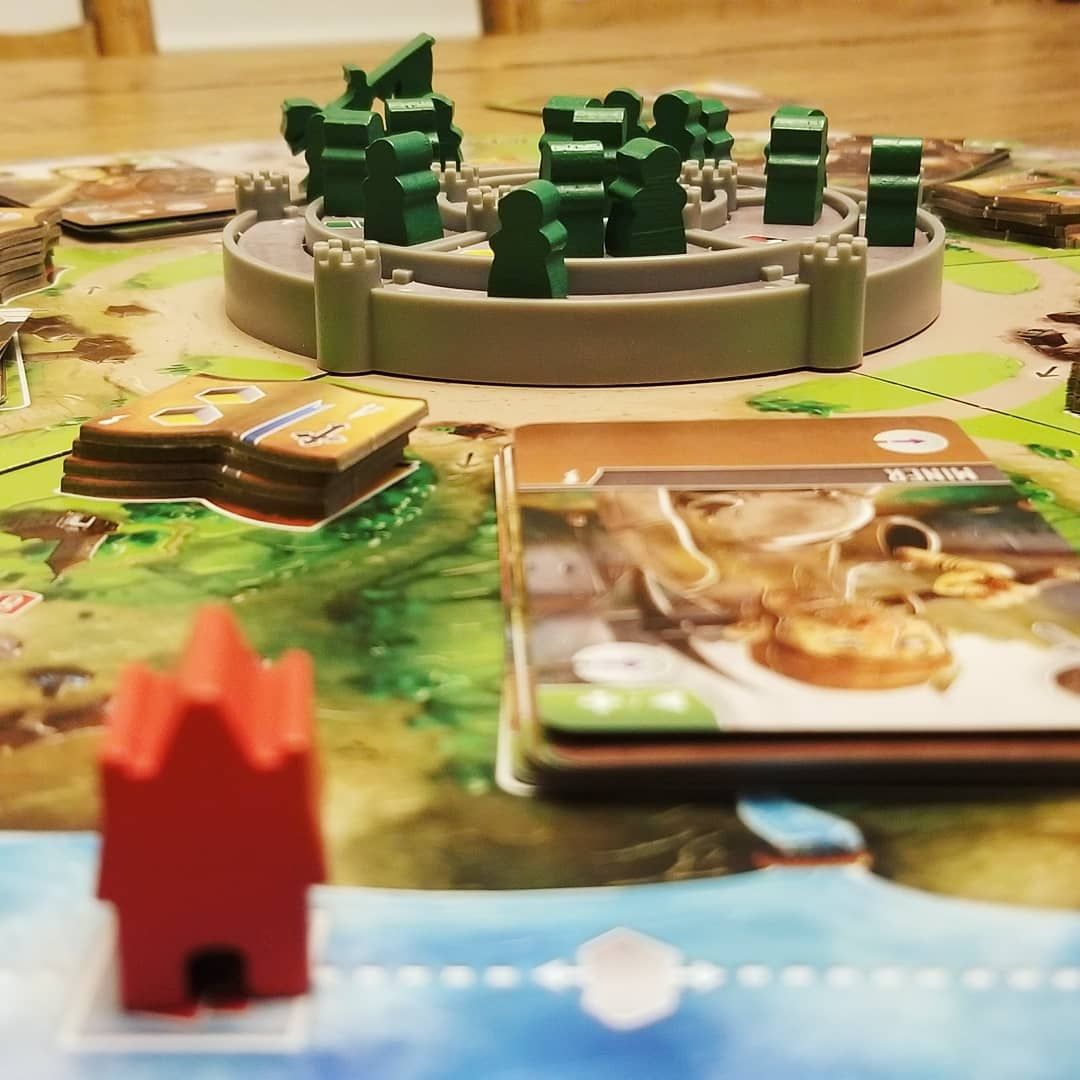
There are a lot of “games within the game” with Viscounts especially the castle. The other one is something I mentioned earlier and that was the “see saw” affect. As your corruption or virtue moves one way or the other, they will reward you with deeds or debts. This can be helpful for points at the end but at the same time, if the deeds run out first, and triggers the game end, the player with the most debts turned over at game end actually scores more bonus points. The same goes with if debts run out and trigger the end game first. This creates an interesting push/pull where you might be running out of deeds faster but need to slow it down in order to collect a few more debts to score the bonus points. But if you don’t flip the debts before end game, you actually lose victory points. I really like how the end of the game is tied to this and really creates some nice tension.
This play session was my 4th time playing solo and my actual first win. I only won by a single point, but I was still really proud. I made a decision to concentrate on construction (and I actually got every building out onto the table) while doing a little bit of publishing. I also made a concentrated effort to keep my deck as small and focused as possible and this really paid off in the end, allowing me to win 120 to 119.
Right now, this is my favorite solo game. Everything about it is fun to me. It’s challenging but not so much that I feel defeated before I even play. The artwork is fantastic. The mechanics flow perfectly. The virtual player’s turns are quick enough to keep the game moving rapidly but have depth. I will knock off a few points because the rule book is a beast of a read, and I don’t think the length of setup will appeal to most players. Even with those things in mind, this game is honestly my hottest pick right now and if the other Garphill Games hold up to this one, I can’t wait to add them to my collection.
And for an example playthrough of the solo mode of Viscounts of the West Kingdom, check out my YouTube video here.
Rating
Ratings are based on 5 main criteria: rulebook, setup, components, art & graphic design, and gameplay. The first 4 criteria are rated 1 to 5 and the gameplay is rated 1 to 10. These scores culminate in an “overall satisfaction” score that is rated from 1 to 10. If the reviewed game has both a solo and multiplayer mode, I have assigned scores separately to give context to which mode we enjoy more.
Links
As an Amazon Associate I earn from qualifying purchases.
Amazon: Viscounts of the West Kingdom
